Nanoscale “Chessboard” Pattern Lamellae in a Supramolecular Perylene-Diimide Polydiacetylene System
Abstract
1. Introduction
2. Results and Discussion
2.1. Supramolecular Complexation
2.2. Chromatic Transitions
2.3. Morphological Properties
2.4. Ionic Conductivity of the 2:1 PDI-Mono(4-imz)/PDCDDA and 1:1 Drop Cast Films
3. Materials
3.1. Materials Synthesis
3.1.1. Representative Drop-Cast Film Preparation
3.1.2. Stimuli Treatment of Films
3.2. Instrumentation
4. Conclusions
Supplementary Materials
Author Contributions
Funding
Data Availability Statement
Acknowledgments
Conflicts of Interest
References
- Huo, J.; Deng, Q.; Fan, T.; He, G.; Hu, X.; Hong, X.; Chen, H.; Luo, S.; Wang, Z.; Chen, D. Advances in polydiacetylene development for the design of side chain groups in smart material applications—A mini review. Polym. Chem. 2017, 8, 7438–7445. [Google Scholar] [CrossRef]
- Okada, S.; Peng, S.; Spevak, W.; Charych, D. Color and chromism of polydiacetylene vesicles. Acc. Chem. Res. 1998, 31, 229–239. [Google Scholar] [CrossRef]
- Sun, X.; Chen, T.; Huang, S.; Li, L.; Peng, H. Chromatic polydiacetylene with novel sensitivity. Chem. Soc. Rev. 2010, 39, 4244–4257. [Google Scholar] [CrossRef]
- Reppy, M.A.; Pindzola, B.A. Biosensing with polydiacetylene materials: Structures, optical properties and applications. Chem. Commun. 2007, 4317–4338. [Google Scholar] [CrossRef]
- Chance, R.; Baughman, R.; Müller, H.; Eckhardt, C.J. Thermochromism in a polydiacetylene crystal. J. Chem. Phys. 1977, 67, 3616–3618. [Google Scholar] [CrossRef]
- Wenzel, M.; Atkinson, G.H. Chromatic properties of polydiacetylene films. J. Am. Chem. Soc. 1989, 111, 6123–6127. [Google Scholar] [CrossRef]
- Yoon, J.; Chae, S.K.; Kim, J.-M. Colorimetric sensors for volatile organic compounds (VOCs) based on conjugated polymer-embedded electrospun fibers. J. Am. Chem. Soc. 2007, 129, 3038–3039. [Google Scholar] [CrossRef]
- Tomioka, Y.; Tanaka, N.; Imazeki, S. Effects of side-group interactions on pressure-induced chromism of polydiacetylene monolayer at a gas-water interface. Thin Solid Film. 1989, 179, 27–31. [Google Scholar] [CrossRef]
- Qian, X.; Sädler, B. Recent developments in polydiacetylene-based sensors. Chem. Mater. 2019, 31, 1196–1222. [Google Scholar] [CrossRef]
- Wegner, G. Topochemische Reaktionen von Monomeren mit konjugierten Dreifachbindungen/Tochemical Reactions of Monomers with conjugated triple Bonds: I. Mitt.: Polymerisation von Derivaten des 2.4-Hexadiin-1.6-diols im kristallinen Zustand. Z. Naturforsch. B 1969, 24, 824–832. [Google Scholar] [CrossRef]
- Wegner, G. Topochemical reactions of monomers with conjugated triple-bonds. IV. Polymerization of bis-(p-toluene sulfonate) of 2.4-hexadiin-1.6-diol. Die Makromol. Chem. Macromol. Chem. Phys. 1971, 145, 85–94. [Google Scholar] [CrossRef]
- Fang, F.; Meng, F.; Luo, L. Recent advances on polydiacetylene-based smart materials for biomedical applications. Mater. Chem. Front. 2020, 4, 1089–1104. [Google Scholar] [CrossRef]
- Lee, J.P.; Hwang, H.; Chae, S.; Kim, J.-M. A reversibly mechanochromic conjugated polymer. Chem. Commun. 2019, 55, 9395–9398. [Google Scholar] [CrossRef] [PubMed]
- Tang, Z.; Li, M.; Song, M.; Jiang, L.; Li, J.; He, Y.; Zhou, L. Good conductivity of a single component polydiacetylene film. Org. Electron. 2017, 49, 174–178. [Google Scholar] [CrossRef]
- Rao, V.K.; Teradal, N.L.; Jelinek, R. Polydiacetylene capacitive artificial nose. ACS Appl. Mater. Interfaces 2019, 11, 4470–4479. [Google Scholar] [CrossRef]
- Dolai, S.; Bhunia, S.K.; Beglaryan, S.S.; Kolusheva, S.; Zeiri, L.; Jelinek, R. Colorimetric polydiacetylene–aerogel detector for volatile organic compounds (VOCs). ACS Appl. Mater. Interfaces 2017, 9, 2891–2898. [Google Scholar] [CrossRef]
- Enkelmann, V. Structural aspects of the topochemical polymerization of diacetylenes. In Polydiacetylenes; Advances in Polymer Science; Springer: Berlin/Heidelberg, Germany, 1984; Volume 63, pp. 91–133. [Google Scholar]
- Krishnan, D.; RB, A.R.; Gowd, E.B. Topochemical polymerization of hierarchically ordered diacetylene monomers within the block copolymer domains. Polym. Chem. 2019, 10, 3154–3162. [Google Scholar] [CrossRef]
- Fan, J.; Xu, X.; Yu, W.; Wei, Z.; Zhang, D. Hydrogen-bond-driven supramolecular self-assembly of diacetylene derivatives for topochemical polymerization in solution. Polym. Chem. 2020, 11, 1947–1953. [Google Scholar] [CrossRef]
- Nyayachavadi, A.; Mason, G.T.; Nazir Tahir, M.; Ocheje, M.U.; Rondeau-Gagné, S. Covalent cross-linking of diketopyrrolopyrrole-based organogels with polydiacetylenes. Langmuir 2018, 34, 12126–12136. [Google Scholar] [CrossRef]
- Da Costa, V.; Le Moigne, J.; Oswald, L.; Pham, T.; Thierry, A. Thin film orientation by epitaxy of carbazolyl polydiacetylenes: Guest-host interaction on a crystal surface. Macromolecules 1998, 31, 1635–1643. [Google Scholar] [CrossRef]
- Ye, Q.; You, X.; Zou, G.; Yu, X.; Zhang, Q. Morphology, structure and chromatic properties of azobenzene-substituted polydiacetylene supramolelular assemblies. J. Mater. Chem. 2008, 18, 2775–2780. [Google Scholar] [CrossRef]
- Shirakawa, M.; Fujita, N.; Shinkai, S. A stable single piece of unimolecularly π-stacked porphyrin aggregate in a thixotropic low molecular weight gel: A one-dimensional molecular template for polydiacetylene wiring up to several tens of micrometers in length. J. Am. Chem. Soc. 2005, 127, 4164–4165. [Google Scholar] [CrossRef] [PubMed]
- Shin, G.; Khazi, M.I.; Kundapur, U.; Kim, B.; Kim, Y.; Lee, C.W.; Kim, J.-M. Cation-directed self-assembly of macrocyclic diacetylene for developing chromogenic polydiacetylene. ACS Macro Lett. 2019, 8, 610–615. [Google Scholar] [CrossRef] [PubMed]
- Phonchai, N.; Khanantong, C.; Kielar, F.; Traiphol, R.; Traiphol, N. Low-temperature reversible thermochromic polydiacetylene/zinc (II)/zinc oxide nanocomposites for colorimetric sensing. ACS Appl. Nano Mater. 2019, 2, 4489–4498. [Google Scholar] [CrossRef]
- Lee, J.; Lee, C.W.; Kim, J.-M. A magnetically responsive polydiacetylene precursor for latent fingerprint analysis. ACS Appl. Mater. Interfaces 2016, 8, 6245–6251. [Google Scholar] [CrossRef]
- Kim, B.; Khazi, M.I.; Kim, J.-M. Nickel-Ion-Coordinated Reversibly Solvatochromic Polydiacetylene Based on Tubular Assembly of Macrocyclic Diacetylene. Macromolecules 2021, 54, 8220–8228. [Google Scholar] [CrossRef]
- Shin, H.; Jannah, F.; Yoo, E.J.; Kim, J.-M. A colorimetric and fluorescence “turn-on” sensor for Fe (III) ion based on imidazole-functionalized polydiacetylene. Sens. Actuators B Chem. 2022, 350, 130885. [Google Scholar] [CrossRef]
- Finney, T.J.; Parikh, S.J.; Berman, A.; Sasaki, D.Y.; Kuhl, T.L. Characterizing and Tuning the Properties of Polydiacetylene Films for Sensing Applications. Langmuir 2021, 37, 12940–12951. [Google Scholar] [CrossRef]
- Yarimaga, O.; Jaworski, J.; Yoon, B.; Kim, J.-M. Polydiacetylenes: Supramolecular smart materials with a structural hierarchy for sensing, imaging and display applications. Chem. Commun. 2012, 48, 2469–2485. [Google Scholar] [CrossRef]
- Ahn, D.J.; Kim, J.-M. Fluorogenic polydiacetylene supramolecules: Immobilization, micropatterning, and application to label-free chemosensors. Acc. Chem. Res. 2008, 41, 805–816. [Google Scholar] [CrossRef]
- Yoon, B.; Lee, S.; Kim, J.-M. Recent conceptual and technological advances in polydiacetylene-based supramolecular chemosensors. Chem. Soc. Rev. 2009, 38, 1958–1968. [Google Scholar] [CrossRef] [PubMed]
- Lim, S.; Cordova, D.L.M.; Robang, A.S.; Kuang, Y.; Ogura, K.S.; Paravastu, A.K.; Arguilla, M.Q.; Ardoña, H.A.M. Thermochromic behavior of polydiacetylene nanomaterials driven by charged peptide amphiphiles. Biomacromolecules 2023, 24, 4051–4063. [Google Scholar] [CrossRef] [PubMed]
- Kadamannil, N.N.; Shames, A.I.; Bisht, R.; Biswas, S.; Shauloff, N.; Lee, H.; Kim, J.-M.; Jelinek, R. Light-Induced Self-Assembled Polydiacetylene/Carbon Dot Functional “Honeycomb”. ACS Appl. Mater. Interfaces 2024, 16, 22593–22603. [Google Scholar] [CrossRef] [PubMed]
- Zhao, J.; Liu, Q.; Tong, X.; Wang, Y.; Cai, K.; Ji, W. Rational Design of Bio-Inspired Peptide Electronic Materials toward Bionanotechnology: Strategies and Applications. Adv. Funct. Mater. 2024, 34, 2401466. [Google Scholar] [CrossRef]
- Würthner, F.; Thalacker, C.; Diele, S.; Tschierske, C. Fluorescent J-type aggregates and thermotropic columnar mesophases of perylene bisimide dyes. Chem.– Eur. J. 2001, 7, 2245–2253. [Google Scholar] [CrossRef]
- Marty, R.; Szilluweit, R.; Sánchez-Ferrer, A.; Bolisetty, S.; Adamcik, J.; Mezzenga, R.; Spitzner, E.-C.; Feifer, M.; Steinmann, S.N.; Corminboeuf, C. Hierarchically structured microfibers of “single stack” perylene bisimide and quaterthiophene nanowires. ACS Nano 2013, 7, 8498–8508. [Google Scholar] [CrossRef]
- Würthner, F.; Chen, Z.; Hoeben, F.J.; Osswald, P.; You, C.-C.; Jonkheijm, P.; Herrikhuyzen, J.v.; Schenning, A.P.; van der Schoot, P.P.; Meijer, E. Supramolecular p− n-heterojunctions by co-self-organization of oligo (p-phenylene vinylene) and perylene bisimide dyes. J. Am. Chem. Soc. 2004, 126, 10611–10618. [Google Scholar] [CrossRef]
- Yagai, S.; Seki, T.; Karatsu, T.; Kitamura, A.; Würthner, F. Transformation from H-to J-aggregated perylene bisimide dyes by complexation with cyanurates. Angew. Chem. Int. Ed. 2008, 47, 3367–3371. [Google Scholar] [CrossRef]
- Chen, Z.; Stepanenko, V.; Dehm, V.; Prins, P.; Siebbeles, L.D.; Seibt, J.; Marquetand, P.; Engel, V.; Würthner, F. Photoluminescence and conductivity of self-assembled π–π stacks of perylene bisimide dyes. Chem.–Eur. J. 2007, 13, 436–449. [Google Scholar] [CrossRef]
- Zhan, X.; Facchetti, A.; Barlow, S.; Marks, T.J.; Ratner, M.A.; Wasielewski, M.R.; Marder, S.R. Rylene and related diimides for organic electronics. Adv. Mater. 2011, 23, 268–284. [Google Scholar] [CrossRef]
- Tahir, M.N.; Nyayachavadi, A.; Morin, J.-F.; Rondeau-Gagné, S. Recent progress in the stabilization of supramolecular assemblies with functional polydiacetylenes. Polym. Chem. 2018, 9, 3019–3028. [Google Scholar] [CrossRef]
- Seo, J.; Khazi, M.I.; Kim, J.-M. Highly responsive triethylamine vapor sensor based on a perylene diimide-polydiacetylene system via heat-induced tuning of the molecular packing approach. Sens. Actuators B Chem. 2021, 334, 129660. [Google Scholar] [CrossRef]
- De Adhikari, A.; Morag, A.; Seo, J.; Kim, J.M.; Jelinek, R. Polydiacetylene–perylenediimide supercapacitors. ChemSusChem 2020, 13, 3230–3236. [Google Scholar] [CrossRef] [PubMed]
- Seo, J.; Kantha, C.; Joung, J.F.; Park, S.; Jelinek, R.; Kim, J.M. Covalently linked perylene diimide–polydiacetylene nanofibers display enhanced stability and photocurrent with reversible FRET phenomenon. Small 2019, 15, 1901342. [Google Scholar] [CrossRef]
- Jiang, H.; Hershtig, G.; Richter, S.; Jelinek, R. Light-induced conductivity in a solution-processed film of polydiacetylene and perylene diimide. J. Phys. Chem. Lett. 2016, 7, 1628–1631. [Google Scholar] [CrossRef]
- Martin, I.J.; Shih, K.-C.; Nieh, M.-P.; Kasi, R.M. Templated supramolecular structures of multichromic, multiresponsive perylene diimide-polydiacetylene films. Macromolecules 2020, 53, 4501–4510. [Google Scholar] [CrossRef]
- Huang, Q.; Wu, W.; Ai, K.; Liu, J. Highly sensitive polydiacetylene ensembles for biosensing and bioimaging. Front. Chem. 2020, 8, 565782. [Google Scholar] [CrossRef]
- Lindsell, W.E.; Preston, P.N.; Seddon, J.M.; Rosair, G.M.; Woodman, T.A. Macroscopic helical and cylindrical morphologies from achiral 1, 3-diynes. Chem. Mater. 2000, 12, 1572–1576. [Google Scholar] [CrossRef]
- Sunilkumar, A.; Chethan, B.; Prasad, V.; Matteppanavar, S. An Overview of Stability, Lifetime, and Reuse of Surfactant Sensors; Royal Society of Chemistry: London, UK, 2023. [Google Scholar]
- Yan, L.; Rank, C.; Mecking, S.; Winey, K.I. Gyroid and other ordered morphologies in single-ion conducting polymers and their impact on ion conductivity. J. Am. Chem. Soc. 2019, 142, 857–866. [Google Scholar] [CrossRef]
- Krishnan, B.P.; Yang, Y.-F.; Woeppel, A.B.; Flores-Hansen, C.; Yeo, H.; Boudouris, B.W. Topochemical Synthesis of Conducting Radical Polymers. Macromolecules 2024, 57, 4747–4756. [Google Scholar] [CrossRef]
- Zhang, Z.; Krajniak, J.; Ganesan, V. A multiscale simulation study of influence of morphology on ion transport in block copolymeric ionic liquids. Macromolecules 2021, 54, 4997–5010. [Google Scholar] [CrossRef]
- He, G.; Li, Z.; Zhao, J.; Wang, S.; Wu, H.; Guiver, M.D.; Jiang, Z. Nanostructured ion-exchange membranes for fuel cells: Recent advances and perspectives. Adv. Mater. 2015, 27, 5280–5295. [Google Scholar] [CrossRef] [PubMed]
- Ju, J.; Hayward, R.C. Interconnected Nanoporous Polysulfone by the Self-Assembly of Randomly Linked Copolymer Networks and Linear Multiblocks. ACS Appl. Mater. Interfaces 2024, 16, 34079–34088. [Google Scholar] [CrossRef]
- Jeong, K.j.; Jeong, S.; Lee, S.; Son, C.Y. Predictive Molecular Models for Charged Materials Systems: From Energy Materials to Biomacromolecules. Adv. Mater. 2023, 35, 2204272. [Google Scholar] [CrossRef]
- Holman, M.W.; Liu, R.; Adams, D.M. Single-molecule spectroscopy of interfacial electron transfer. J. Am. Chem. Soc. 2003, 125, 12649–12654. [Google Scholar] [CrossRef]
- Tran, H.; Gopinadhan, M.; Majewski, P.W.; Shade, R.; Steffes, V.; Osuji, C.O.; Campos, L.M. Monoliths of semiconducting block copolymers by magnetic alignment. ACS Nano 2013, 7, 5514–5521. [Google Scholar] [CrossRef]
- Yao, Y.; Dong, H.; Liu, F.; Russell, T.P.; Hu, W. Approaching intra-and interchain charge transport of conjugated polymers facilely by topochemical polymerized single crystals. Adv. Mater. 2017, 29, 1701251. [Google Scholar] [CrossRef]
- Kim, J.-M.; Lee, J.-S.; Choi, H.; Sohn, D.; Ahn, D.J. Rational design and in-situ FTIR analyses of colorimetrically reversibe polydiacetylene supramolecules. Macromolecules 2005, 38, 9366–9376. [Google Scholar] [CrossRef]
- Xu, Y.; Jiang, H.; Zhang, Q.; Wang, F.; Zou, G. Helical polydiacetylene prepared in the liquid crystal phase using circular polarized ultraviolet light. Chem. Commun. 2014, 50, 365–367. [Google Scholar] [CrossRef]
- Orchard, B.; Tripathy, S. Molecular structure and electronic property modification of poly (diacetylenes). Macromolecules 1986, 19, 1844–1850. [Google Scholar] [CrossRef]
- Kim, H.; Khazi, M.I.; Kim, J.-M. Preparation and colorimetric response of an aldehyde-functionalized macrocyclic diacetylene-derived polydiacetylene. Dyes Pigments 2021, 187, 109114. [Google Scholar] [CrossRef]
- Kim, B.; Heo, J.-M.; Khazi, M.I.; Kim, J.-M. Reversible solvatochromism of polydiacetylenes based on extensively hydrogen-bonded tubular arrays. Macromolecules 2021, 54, 2485–2493. [Google Scholar] [CrossRef]
- Khazi, M.I.; Balachandra, C.; Shin, G.; Jang, G.-H.; Govindaraju, T.; Kim, J.-M. Co-solvent polarity tuned thermochromic nanotubes of cyclic dipeptide–polydiacetylene supramolecular system. RSC Adv. 2020, 10, 35389–35396. [Google Scholar] [CrossRef] [PubMed]
- Hema, K.; Ravi, A.; Raju, C.; Sureshan, K.M. Polymers with advanced structural and supramolecular features synthesized through topochemical polymerization. Chem. Sci. 2021, 12, 5361–5380. [Google Scholar] [CrossRef]
- Badarau, C.; Wang, Z.Y. Synthesis and optical properties of thermally and photochemically cross-linkable diacetylene-containing polymers. Macromolecules 2004, 37, 147–153. [Google Scholar] [CrossRef]
- Kim, T.-H.; Kang, S.-H.; Doe, C.; Yu, J.; Sim, J.-B.; Kim, J.; Kline, S.R.; Choi, S.-M. Highly Ordered Self-Assembly of 1D Nanoparticles in Phospholipids Driven by Curvature and Electrostatic Interaction. J. Am. Chem. Soc. 2009, 131, 7456–7460. [Google Scholar] [CrossRef]
- Scherlis, D.A.; Marzari, N. π-Stacking in thiophene oligomers as the driving force for electroactive materials and devices. J. Am. Chem. Soc. 2005, 127, 3207–3212. [Google Scholar] [CrossRef]
- Xu, A.; Zhang, Y.; Li, Z.; Wang, J. Viscosities and conductivities of 1-butyl-3-methylimidazolium carboxylates ionic liquids at different temperatures. J. Chem. Eng. Data 2012, 57, 3102–3108. [Google Scholar] [CrossRef]
- Press, J.B.; Wright Jr, W.B.; Chan, P.S.; Marsico, J.W.; Haug, M.F.; Tauber, J.; Tomcufcik, A.S. Thromboxane synthetase inhibitors and antihypertensive agents. 2. N-[(1H-Imidazol-1-yl) alkyl]-1H-isoindole-1, 3 (2H)-diones and N-[(1H-1, 2, 4-triazol-1-yl) alkyl]-1H-isoindole-1, 3 (2H)-diones as unique antihypertensive agents. J. Med. Chem. 1986, 29, 816–819. [Google Scholar] [CrossRef]
- Hay, M.P.; Wilson, W.R.; Moselen, J.W.; Palmer, B.D.; Denny, W.A. Hypoxia-selective antitumor agents. 8. Bis (nitroimidazolyl) alkanecarboxamides: A new class of hypoxia-selective cytotoxins and hypoxic cell radiosensitizers. J. Med. Chem. 1994, 37, 381–391. [Google Scholar] [CrossRef]
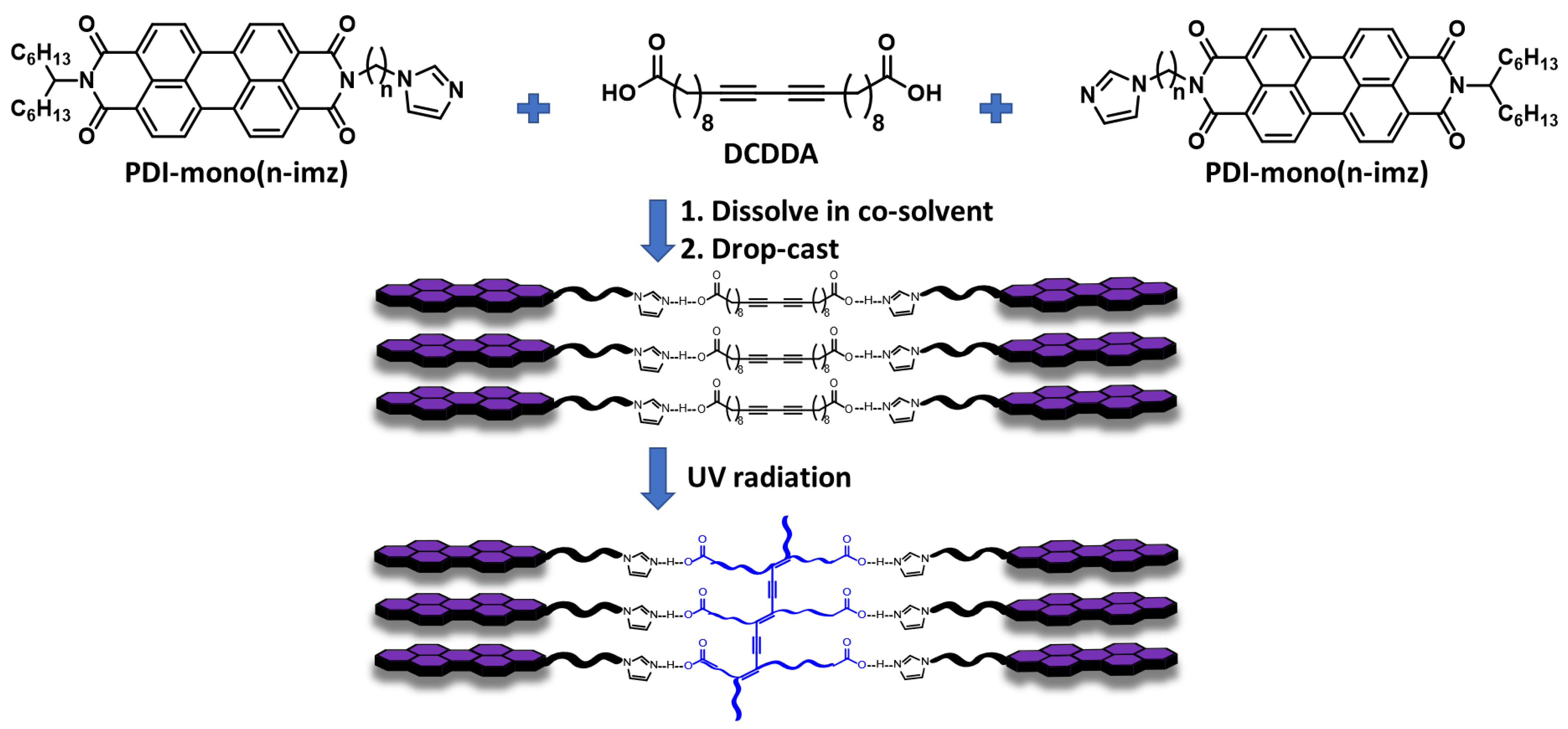
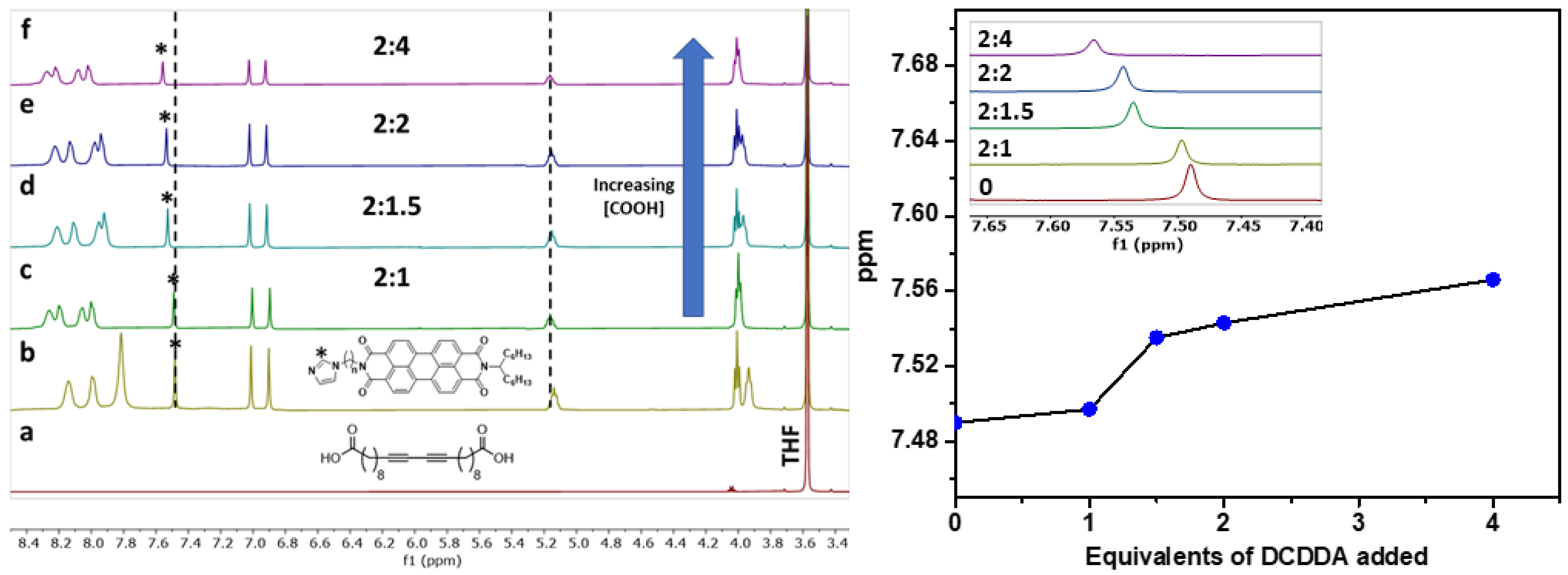
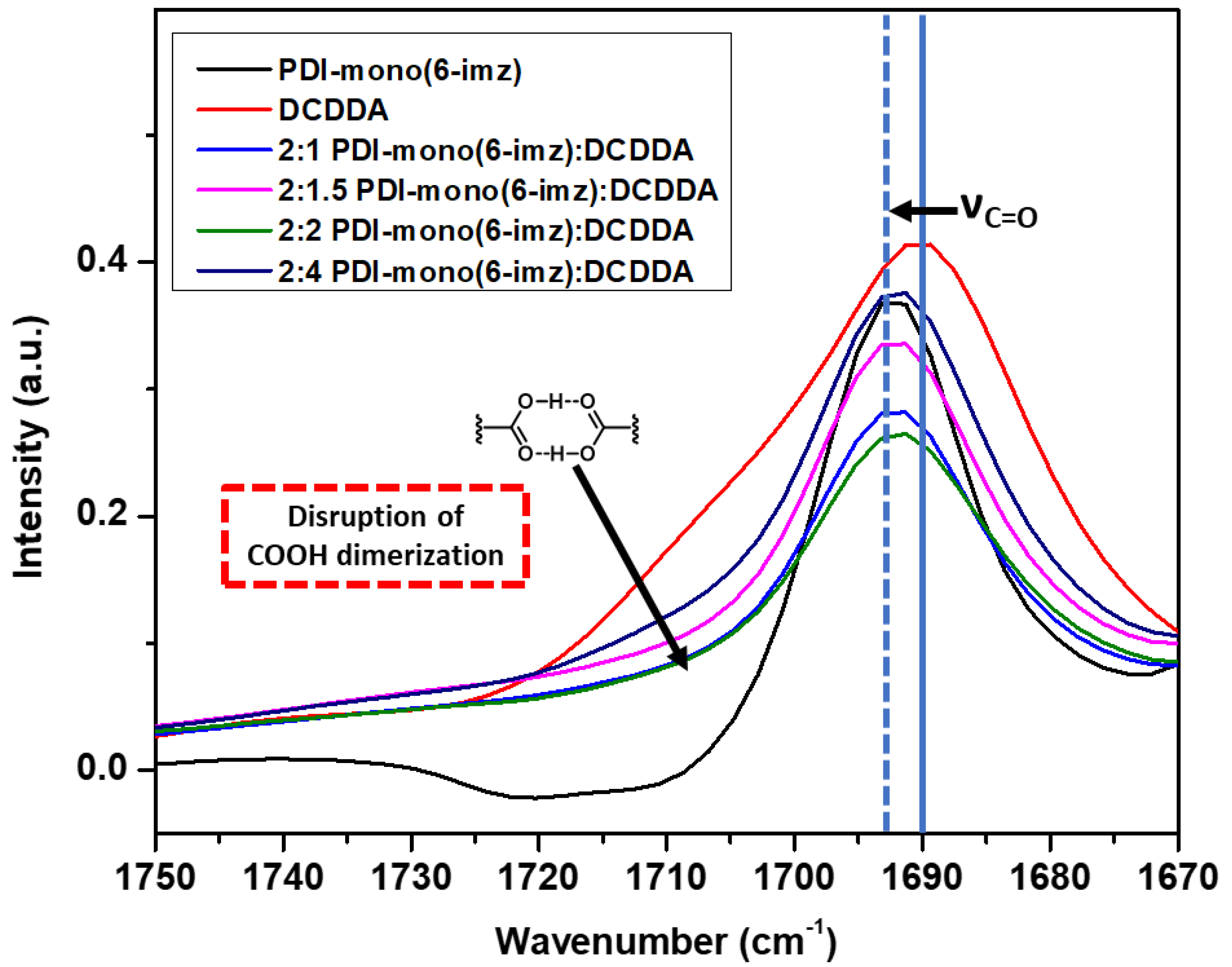
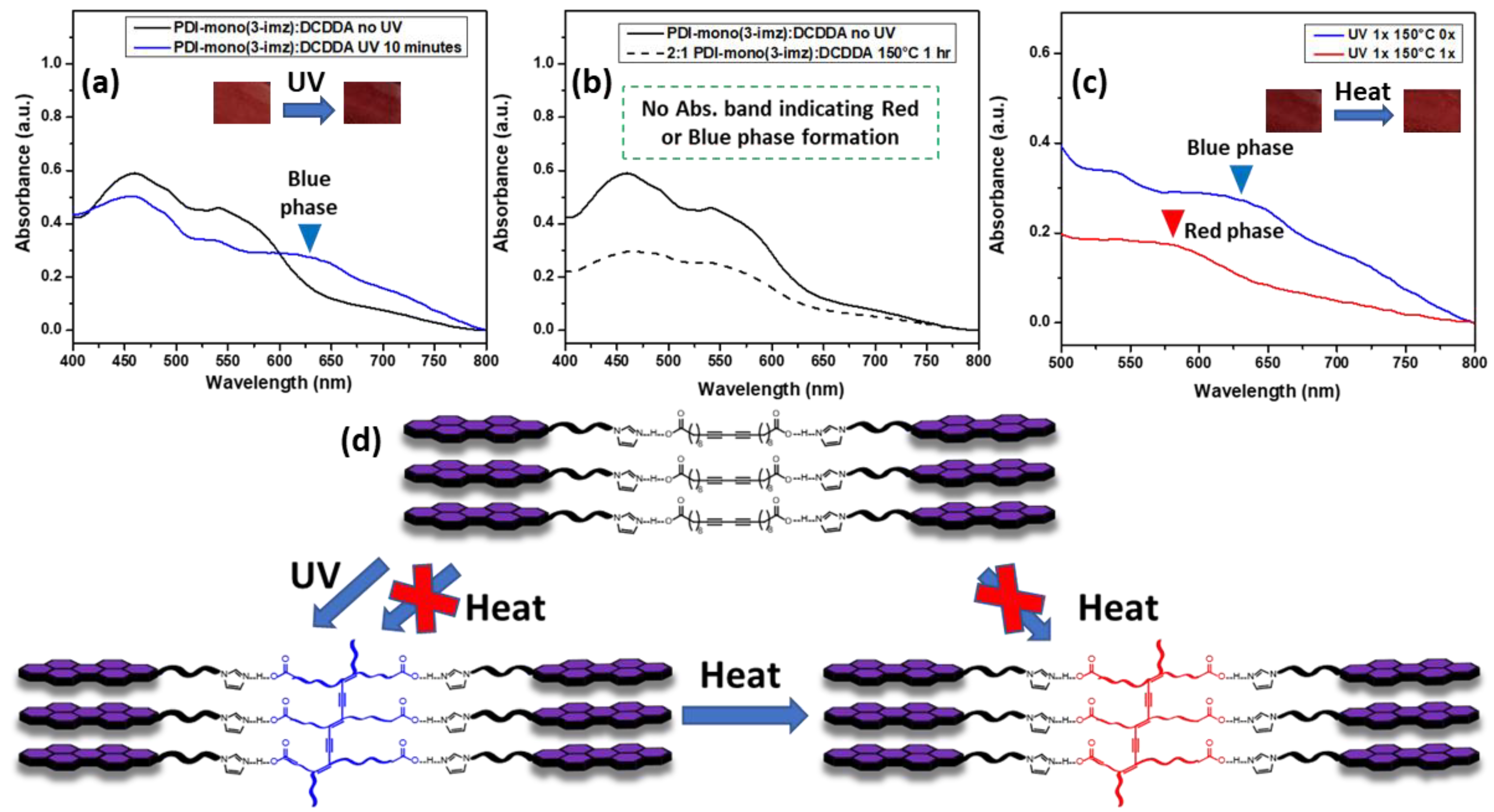
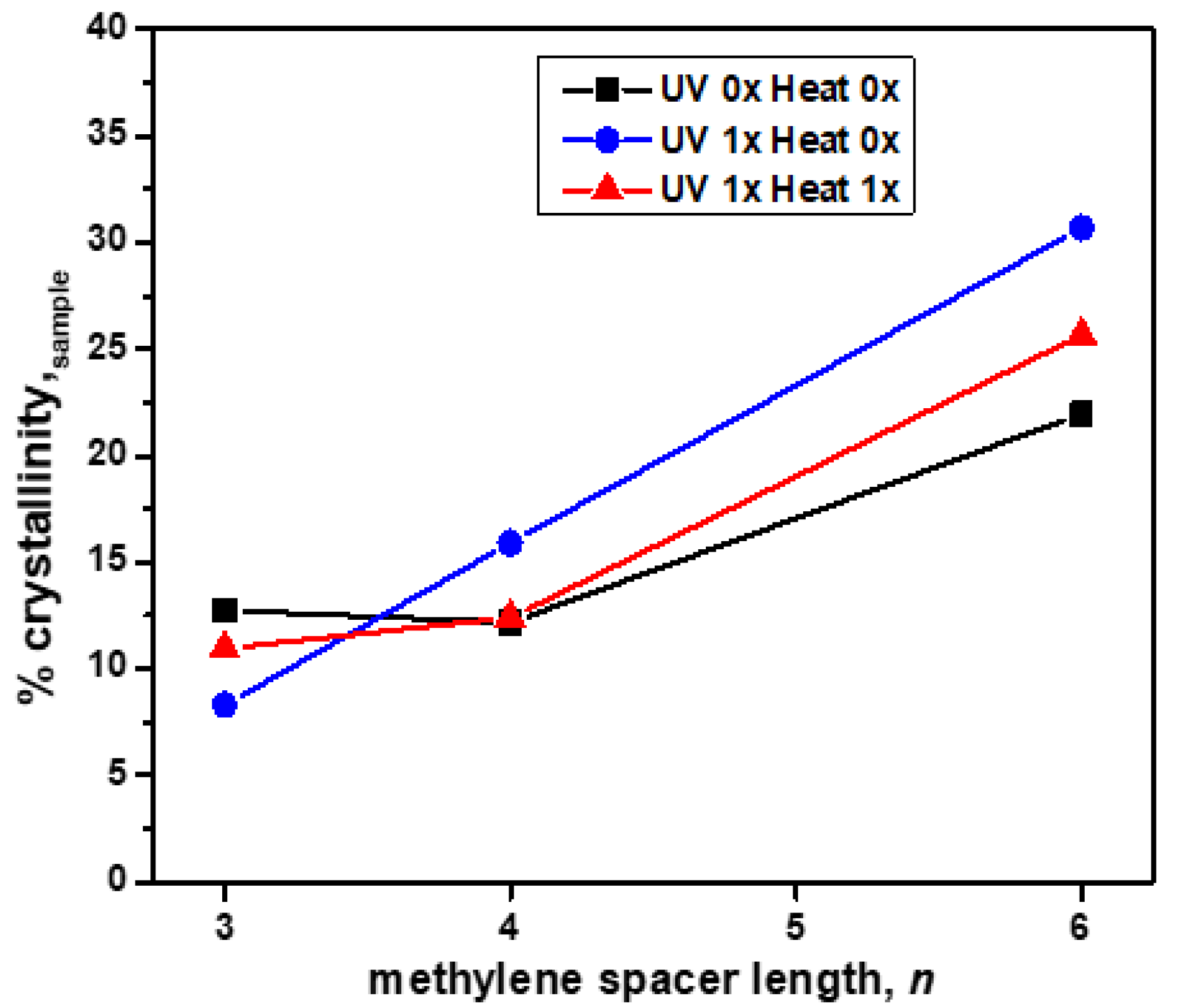
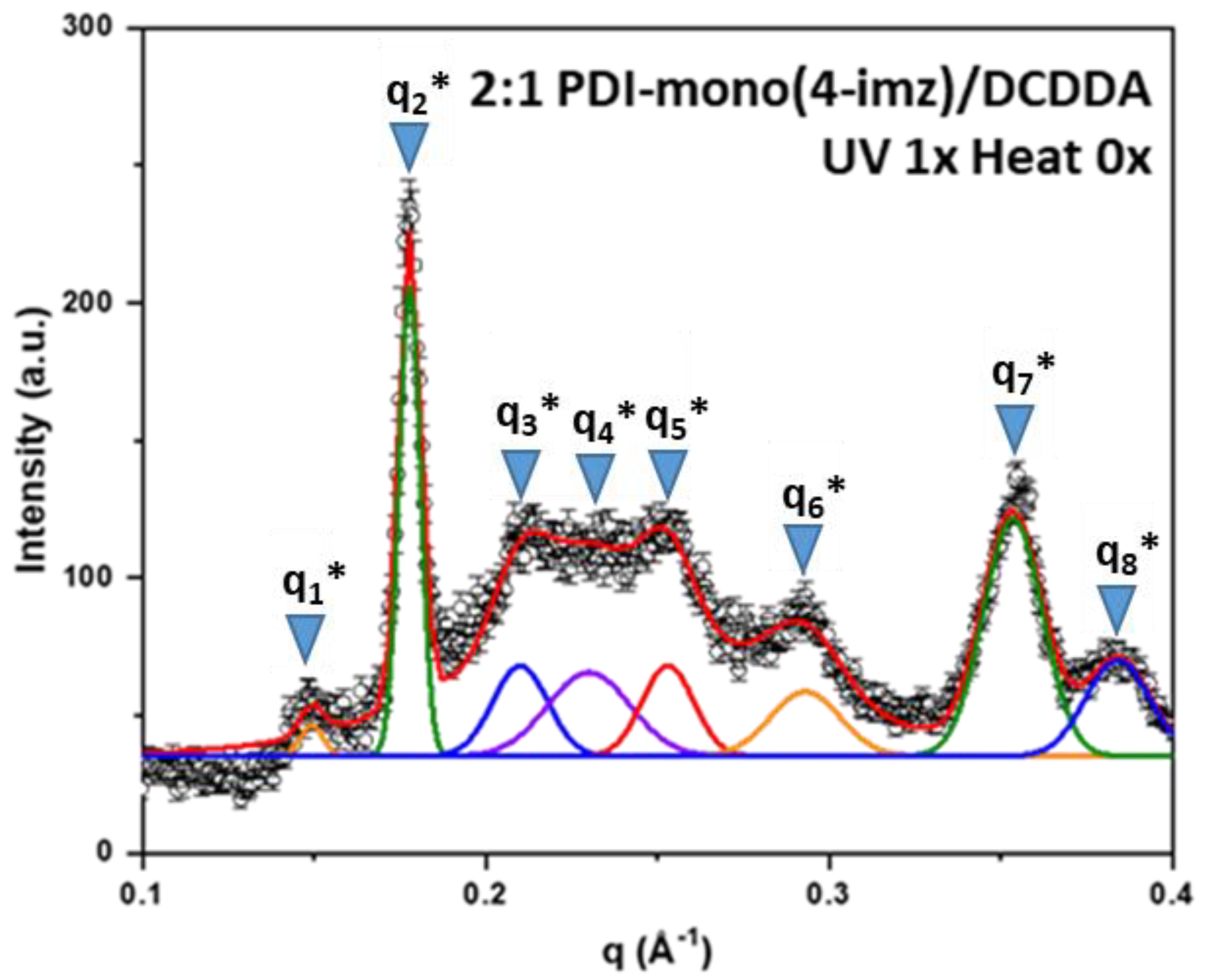

| Peak Assignment | q (Å−1) | d-Spacing (Å) from the 1st Order |
|---|---|---|
| q1*: the 1st-order Bragg reflection along the a axis (indicating the molecular length) | 0.149 | 42.1 |
| q2*: the 1st-order Bragg reflection interlamellar distance | 0.178 | 35.3 |
| q3*: the 1st-order Bragg reflection indicating the repeat spacing along the b axis. | 0.210 | 29.9 |
| q4*: the 1st-order Bragg reflection indicating the repeat spacing along the l axis | 0.240 | 26.2 |
| q5*: Bragg reflection of the (1,1) plane | 0.253 | - |
| q6*: the 2nd-order reflection for q1* | 0.293 | - |
| q7*: the 2nd-order reflections for q2* | 0.353 | - |
| q8*: from PDI-mono(4-imz) polymer | 0.384 | - |
| Sample Name | Applied Outer Current (mA) | Measured Voltage (mV) | Sheet Resistance (Ohms/Square) | Resistivity (Ohm.cm) | Conductivity (mS/cm) |
|---|---|---|---|---|---|
| 1:1 PDI-mono(4-imz)/PCDDA | 3.20 × 10−3 | 3.78 | 4077.862 | 4.0777 | 2.610 × 10−3 |
| 2:1 PDI-mono(4-imz)/PCDDA | 3.6 × 10−3 | 2.01 | 2100.333 | 2.1003 | 4.994 × 10−3 |
Disclaimer/Publisher’s Note: The statements, opinions and data contained in all publications are solely those of the individual author(s) and contributor(s) and not of MDPI and/or the editor(s). MDPI and/or the editor(s) disclaim responsibility for any injury to people or property resulting from any ideas, methods, instructions or products referred to in the content. |
© 2025 by the authors. Licensee MDPI, Basel, Switzerland. This article is an open access article distributed under the terms and conditions of the Creative Commons Attribution (CC BY) license (https://creativecommons.org/licenses/by/4.0/).
Share and Cite
Martin, I.J.; Masese, F.K.; Shih, K.-C.; Nieh, M.-P.; Kasi, R.M. Nanoscale “Chessboard” Pattern Lamellae in a Supramolecular Perylene-Diimide Polydiacetylene System. Molecules 2025, 30, 1207. https://doi.org/10.3390/molecules30061207
Martin IJ, Masese FK, Shih K-C, Nieh M-P, Kasi RM. Nanoscale “Chessboard” Pattern Lamellae in a Supramolecular Perylene-Diimide Polydiacetylene System. Molecules. 2025; 30(6):1207. https://doi.org/10.3390/molecules30061207
Chicago/Turabian StyleMartin, Ian J., Francis Kiranka Masese, Kuo-Chih Shih, Mu-Ping Nieh, and Rajeswari M. Kasi. 2025. "Nanoscale “Chessboard” Pattern Lamellae in a Supramolecular Perylene-Diimide Polydiacetylene System" Molecules 30, no. 6: 1207. https://doi.org/10.3390/molecules30061207
APA StyleMartin, I. J., Masese, F. K., Shih, K.-C., Nieh, M.-P., & Kasi, R. M. (2025). Nanoscale “Chessboard” Pattern Lamellae in a Supramolecular Perylene-Diimide Polydiacetylene System. Molecules, 30(6), 1207. https://doi.org/10.3390/molecules30061207








